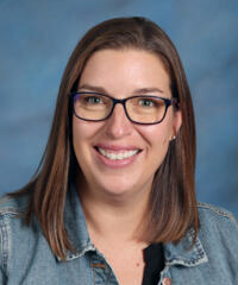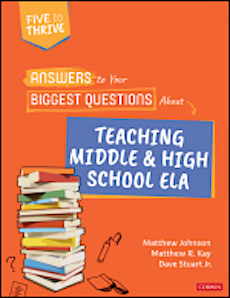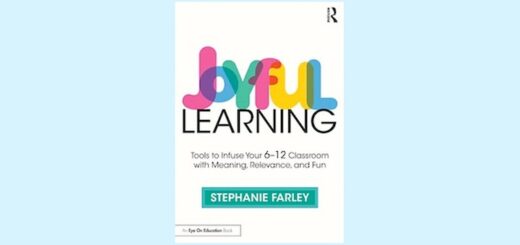Answers to the 5 Biggest ELA Teaching Questions
Answers to Your Biggest Questions About Teaching Middle & High School ELA
By Matthew Johnson, Matthew R. Kay, and Dave Stuart Jr.
(Corwin Press, Five to Thrive series, 2022 – Learn more)
Reviewed by Kelli Stuhr

Zero.
After a while, I adjusted my expectations. Just one practical idea I could use in my classroom made a conference worthwhile. If I got two or three nuggets that I could put into play, that was a great conference.
This book was better than any of those conferences. It blew my expectations out of the water. I have 15 sticky notes hanging out of this book. Each one has one or two ideas or adjustments I want to make during the school year. I feel like I have won the professional development lottery.
Succinct but meaty

As a teacher with 20+ years of middle school experience, I can’t imagine how many notes I would have written when I was first starting out. This is a must-read book for any newer teacher of ELA, but I also recommend it for those who (like me) have been in the classroom for a while.
Teaching Middle & High School ELA – one of Corwin’s Five to Thrive series – has 5 main sections:
● How do I build a brave and supportive reading and writing community?
● How do I cultivate motivation in an ELA classroom?
● How can I ensure that my feedback and assessment are as efficient, effective and equitable as possible?
● What does strong ELA instruction look like?
● How can I keep doing this for my whole career?
These are critical issues to work through on the road to success – success for students as well as for yourself. Each section addresses 7-11 questions with thoughtful pedagogy and practical tips. Each section includes embedded QR codes to worksheets, videos, and mentor texts as well as a list of other books for further reading.
I gained the most tidbits from the sections on classroom community and “how to sustain this career.” I’ve just finished a year of teaching where the students didn’t seem to have the work ethic I’m used to nor were they kind to one another.Perhaps you relate.
I tried in various ways to motivate students (praising those who were on task, emailing home about those who weren’t, rewards for good work or good effort or kindness, creating competitive challenges to see who could get done first, gamifying tasks when possible, etc), but the effects were minimal.
It was challenging and not nearly as enjoyable as it’s been to teach in the past, which made me wonder if it might be time to move on from this career. My gut reaction is to blame the pandemic – students were stunted in their emotional growth and were accustomed to doing what they wanted when they wanted. This book has given me hope (and practical ideas!) that this new school year can be better.
The impact of community on academic success
As any ELA teacher knows, the number of standards we are expected to teach is overwhelming, so building community can get lost in the shuffle. That’s a mistake. Johnson, Kay, and Stuart’s description of community reminds us how it impacts academic success:
“What we’re after is the active construction of class cultures that are courageous, curious, and collaborative: social places where students listen to each other, finding themselves both pushed and secure, challenged and inspired. We want a classroom where students measure their strengths and successes based on their own growth.”
Yes, that’s exactly what I want my classroom to be like. I do work to build community, but this book has shown me I can do better. It has activities to kick off the year, but it emphasizes that “true community is not built with a couple of initial exercises.”
There are ideas for activities we can use throughout the year as well as processes we can put into place so students are working collaboratively to support and encourage one another and build off each others’ thoughts.
Reaching beyond survival
A positive community can be just the medicine needed to avoid burnout, but the section titled “How Can I Keep Doing This for My Entire Career” has specific advice for teachers. One that is a must-try for me is called 5-Out, 5-In. The idea is to walk for five minutes away from school toward something in nature, even if it’s the sole tree on the property. When five minutes is up, turn around and walk back. This should be done without distraction – no noise, no podcast or audiobook, no scrolling on the phone. Just walk at whatever pace feels comfortable and breathe.
Another key takeaway is the concept of being a satisficer – doing the minimum necessary – for some tasks. It’s impossible to do every aspect of teaching at top level. If there is a task that is senseless, do it at the minimal level. Satisfice it. Put energy into what is most important (for me, that would be giving timely feedback to students’ writing).
Great advice from active teachers
In summary, this book is a valuable resource with accessible, critical information for real teachers written by real teachers. That’s right, all three authors are actively teaching. They managed to put this book together during the pandemic (fall of 2021). The past few years have been a roller coaster of changes and challenges for classrooms. Matthew Johnson, Matthew R. Kay and Dave Stuart Jr. managed to write a book that has an optimistic tone despite all the challenges we know they faced.
Kelli Stuhr received her education degree with a major in English and a minor in Spanish from the University of Wisconsin Platteville. After two years of teaching high school, she was surprised to learn she genuinely missed the interaction she had during her student teaching internship with seventh graders. She was elated to land a job in a middle school where she has spent over two decades teaching seventh and eighth grade. Middle school is where she is happy to be.

































